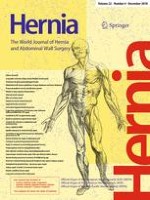Erschienen in:

27.08.2018 | Original Article
Sublay repair results in superior mesh incorporation and histological fibrogenesis in comparison to onlay and primary suture in an experimental rat model
verfasst von:
F. Ponce Leon, J. E. F. Manso, V. L. Abud, W. Nogueira, P. C. Silva, R. Martinez
Erschienen in:
Hernia
|
Ausgabe 6/2018
Einloggen, um Zugang zu erhalten
Abstract
Purpose
To compare adhesion scores, repair strength and histological findings among sublay, onlay and primary repair incisional hernioplasty techniques. Surgical repairs were employed directly on healthy animals, without previous hernia induction, to avoid confounding factors related to hernia development.
Methods
Forty Wistar rats were divided into four groups, control, simulation, onlay and sublay. After 42 days, adhesion intensity, tensile strength of the abdominal wall and anatomopathological histological substrate were compared.
Results
SL group presented greater adhesion scores (p < 0.0001), higher tensiometric (p < 0.0001), and was characterized by more histiocytes, mononuclear cells, macrovacuolar granulomas and type I collagen on histological analysis. Pearson correlation between adhesions and tensiometry, and between tensiometry and neocollagenization showed a strong positive association (r = 0.8905 and 0.6757, respectively in SL group, p < 0.05).
Conclusion
Mesh positioning in sublay compartment was followed by increased adhesion development and provides a stronger mesh–tissue attachment, in addition, resulted in a different histological profile of the inflammation/repair substrate. The intensity of these findings was directly correlated, suggesting they could be the result of a common biological phenomenon. Our findings indicate that mesh placement following the retromuscular technique generates a superior repair response, and give clues to a better understanding of the superiority of sublay repair in achieving lower recurrence rates. Characterization of the cellular and molecular elements responsible for the superiority of this technique is in our view an essential prerequisite aiming for improvements in the therapeutic options for the treatment of this disease.











